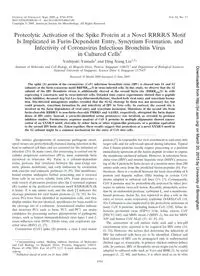
2009 Proteolytic Activation of the Spike Protein at a Novel RRRR_S Motif Is Implicated in Furin-Dependent Entry, Syncyti PDF
Preview 2009 Proteolytic Activation of the Spike Protein at a Novel RRRR_S Motif Is Implicated in Furin-Dependent Entry, Syncyti
JOURNAL OF VIROLOGY, Sept. 2009, p. 8744–8758 Vol. 83, No. 17 0022-538X/09/$08.00�0 doi:10.1128/JVI.00613-09 Copyright © 2009, American Society for Microbiology. All Rights Reserved. Proteolytic Activation of the Spike Protein at a Novel RRRR/S Motif Is Implicated in Furin-Dependent Entry, Syncytium Formation, and Infectivity of Coronavirus Infectious Bronchitis Virus in Cultured Cells� Yoshiyuki Yamada1 and Ding Xiang Liu1,2* Institute of Molecular and Cell Biology, 61 Biopolis Drive, Proteos, Singapore 138673,1 and Department of Biological Sciences, National University of Singapore, Science Drive 4, Singapore 1175432 Received 25 March 2009/Accepted 13 June 2009 The spike (S) protein of the coronavirus (CoV) infectious bronchitis virus (IBV) is cleaved into S1 and S2 subunits at the furin consensus motif RRFRR537/S in virus-infected cells. In this study, we observe that the S2 subunit of the IBV Beaudette strain is additionally cleaved at the second furin site (RRRR690/S) in cells expressing S constructs and in virus-infected cells. Detailed time course experiments showed that a peptide furin inhibitor, decanoyl-Arg-Val-Lys-Arg-chloromethylketone, blocked both viral entry and syncytium forma- tion. Site-directed mutagenesis studies revealed that the S1/S2 cleavage by furin was not necessary for, but could promote, syncytium formation by and infectivity of IBV in Vero cells. In contrast, the second site is involved in the furin dependence of viral entry and syncytium formation. Mutations of the second site from furin-cleavable RRRR/S to non-furin-cleavable PRRRS and AAARS, respectively, abrogated the furin depen- dence of IBV entry. Instead, a yet-to-be-identified serine protease(s) was involved, as revealed by protease inhibitor studies. Furthermore, sequence analysis of CoV S proteins by multiple alignments showed conser- vation of an XXXR/S motif, cleavable by either furin or other trypsin-like proteases, at a position equivalent to the second IBV furin site. Taken together, these results suggest that proteolysis at a novel XXXR/S motif in the S2 subunit might be a common mechanism for the entry of CoV into cells. The surface glycoproteins of numerous pathogenic envel- oped viruses are proteolytically matured during infection in the host or cultured cell lines and are essential for the initiation of infection (33). In many cases, this processing is carried out by cellular proprotein convertases (PCs), most commonly furin (reviewed in reference 46). Furin is a calcium-dependent serine protease that circulates between the trans-Golgi net- work, plasma membrane, and early endosome by association with exocytic and endocytic pathways (9, 39). This membrane- bound enzyme undergoes further processing and is secreted from cells in an active soluble form (49). Furin processes a wide variety of precursor proteins after the C-terminal arginine (R) residue in the preferred consensus motif RXR(K)R/X (K is lysine, X is any amino acid, and the slash [/] indicates the cleavage position) for viral fusion proteins (2, 32, 33). So far, seven PCs have been identified in mammalian cells, and they display similar, but not identical, specificities for basic motifs at the cleavage site of a substrate. Accumulated studies indicate that secretory PCs, such as furin, PC5, and PC7, are major candidates for processing surface glycoproteins of pathogenic viruses, such as human immunodeficiency virus types 1 and 2, avian influenza virus H5N1, Ebola virus, and respiratory syn- cytial virus (RSV) (2, 27). Coronavirus (CoV) spike (S) protein, a class I viral fusion protein (7), is responsible for viral attachment to and entry into target cells and for cell-to-cell spread during infection. Typical class I fusion proteins usually require processing at a position immediately upstream of the fusion peptide in order to expose the membrane-anchored subunit. However, in infectious bron- chitis virus (IBV) and murine hepatitis virus (MHV), process- ing of the S protein by furin occurs at a position more than 200 amino acids away from the predicted fusion peptides (6). Fur- thermore, there is a tradeoff between the furin cleavability of S protein and heparin sulfate (HS) binding in certain CoV strains adapted to cultured cell lines (15, 17). Consequently, CoV S proteins may be proteolytically activated by other pro- teases to initiate virus-cell fusion. Recently, proteolytic activa- tion by an endosomal protease, cathepsin L, and a membrane- bound protease, factor Xa, was reported to play a role in the entry of severe acute respiratory syndrome (SARS)-CoV (18, 45). Cathepsin is also implicated in the proteolytic activation of many CoV S proteins, including human CoV 229E, feline in- fectious peritonitis virus (FIPV) 1146, feline enteric CoV (FECV) 1683, and MHV strain 2 (MHV-2), but not for MHV A59 and human CoV NL63 (31, 41, 43, 45). The association of cell surface sialic acid and a low-pH environment were reported to be required for IBV entry (14, 51, 52). However, the factors that determine the infectivity of IBV for cultured cells have yet to be identified. Clinical and field isolates of IBV can be propagated only in embryonated chicken eggs or, transiently, in primary chicken embryo kidney cells. In contrast, IBV of Beaudette strain origin can be readily adapted to cultured cells, such as Vero and BHK-21, by serial passages (1, 22, 40), and hence, it is often used as an in vitro * Corresponding author. Mailing address: Institute of Molecular and Cell Biology, 61 Biopolis Drive, Proteos, Singapore 138673. Phone: 65 6586 9581. Fax: 65 6779 1117. E-mail:
